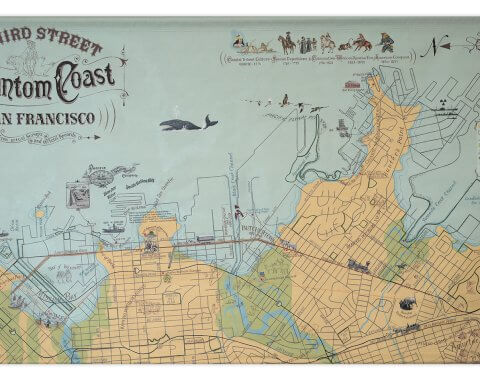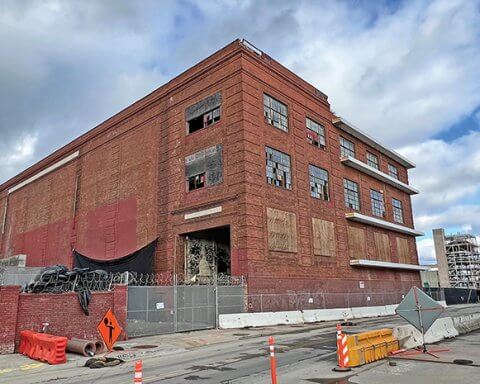Last summer, two schools moved into the Enola Maxwell campus, 655 De Haro Street, which’d been largely vacant for more than a year after International Studies Academy relocated to different grounds. One of the two institutions now housed on the site is San Francisco International High School, San Francisco Unified School District’s only school dedicated exclusively to accommodating newly immigrated teenagers. The other fresh tenant is the New School of San Francisco, a tuition-free charter school that currently serves kindergarteners through third-graders.
The New School of San Francisco educates 184 pupils on the first floor of the three-story Enola Maxwell building; the high schoolers occupy the upper two. Inaugurated in 2015, the New School moved to Potrero Hill after two years at 19th and Alabama streets. According to head of school, Emily Bobel Kilduff, the new space is three and a half times larger than the old one, where they started with only 80 students. “Even just having a blacktop and not having to walk 15 minutes each way to a park is pretty game-changing,” she said.
Bobel Kilduff noted that New School was able to secure its latest campus owing to Proposition 39, the 2000 ballot initiative that declared that California public school facilities should be shared fairly among all public school students, including those in charters. She described it as “a legal process that guarantees a charter school space from the district, space that’s considered adequate and comparable to another public school. It’s a somewhat lengthy process that we went through with the District, but essentially we put forward our preferences, and we preferred the Potrero-Mission area because that’s where we opened our doors two years ago, and we wanted to stay in the vicinity so the move was as feasible for our families as possible.”
She added that the New School is “intentionally diverse. We want our school demographics to mirror the demographics of San Francisco, which means including people of all backgrounds and neighborhoods in the City, so it was our priority to be centrally located, and given that there is a higher percentage of low-income families in the south and southeast parts of the City, we wanted to be more accessible to those families, who have the greatest barriers to being able to access great schools.”
The New School’s primary distinguishing characteristic, according to Bobel Kilduff, is its pedagogical method, which follows an inquiry-based learning model, as opposed to problem- or project-based education. Inquiry-based learning introduces “big questions” – like, “What did the Big Bang look and feel like?” or “Why is there injustice in the world?” – that center on students’ curiosities, allowing them to accumulate knowledge through the exploratory process of addressing those queries, instead of assigning them predetermined projects or problem sets.
“I’m an educator,” Bobel Kilduff explained, “so I started as a classroom teacher. I was trained in a very traditional way, which the vast majority of educators are trained in, which is the assumption that the teacher is the one that holds the knowledge, and it’s our job to impart the knowledge to children. And that is guided by a set of state standards that you follow, and we just need to make sure that the kids master those standards, and we assess on those standards, and that’s how we know whether or not kids are successful. I’ve now come to believe that that is a pretty worrisome way to think about how we educate children, and in many ways really doesn’t map to what a growing body of research – and research that’s been out for hundreds of years – would tell us about how children learn and develop.”
New School seeks to flip the traditional model on its head. “Instead of starting with the adult being the one who holds the knowledge and the information, we start with the premise that kids come to us with a lot of knowledge and information, a lot of great questions, and are curious and passionate about learning. In an inquiry-based model, instead of starting with what kids must know, we start with a ‘big question,’ and we of course use that question to follow Common Core standards, because, like any public school, we’re held accountable to those standards of what one is supposed to know in kindergarten and first grade. And we believe the Common Core standards are rigorous and great; we just believe that there’s a way you can get to Common Core standards that’s really engaging for kids, that’s very hands-on.”
New School works with the Exploratorium’s Institute for Inquiry to develop curriculum that integrate specific content into broader study arcs, so that “the learning feels very relevant and connected and fun for kids.”
New School began as the brainchild of Bobel Kilduff – a Stanford University graduate who taught middle school in the South Bronx before moving into “various leadership positions” with Teach for America, where she worked to build a “pipeline of educators who are committed to disrupting the status quo” – and fellow head of school, Ryan Chapman, another Teach for America alumnus. While some charter schools are founded by for-profit corporations, theirs was an independent, personal effort, undertaken after two years spent “visiting different school models and building out the blueprint for the design of the school.”
Ultimately, they created a petition for their charter and took it to SFUSD, which denied them on the grounds that they lacked a “sound educational model.” Bobel Kilduff and Chapman appealed the decision to the State Board of Education, which overturned the District’s ruling.
“Not only did the state disagree; the state board has ten members, and we had a unanimous decision, so not one state board member believed our educational model was unsound,” Bobel Kilduff recalled. “And what I would also say about that hearing is that it was clear they had done more of their due diligence in actually reading our petition, in terms of the specificity of the questions and the level of the questioning we got at the state level versus the district level. In many ways, I think San Francisco Unified is a very anti-charter school district, and had probably made up their minds before they saw our petition.”
Bobel Kilduff calls New School a “boutique charter; we’re kind of a stand-alone pilot.” With growth and success, a boutique charter can ultimately “become a charter management organization, having multiple campuses with a central office, managing several school sites. We’re clearly not there yet. We feel like just trying to demonstrate that you can do inquiry in a public school with a diverse set of learners is challenging enough for us to be focused on. One of our intentions is to be a laboratory school for San Francisco and the Exploratorium and beyond, so that the work we’re doing and what we’re learning isn’t done in a silo or on an island of privilege, serving just a small number of kids, but rather the curriculum we’re developing, what we’re learning about inquiry, the individualized learning plans, everything we’re doing is open-source, so our impact can be broader than just the four walls of our building.”
Federal grants initially funded New School’s creation, paying for supplies and teacher salaries. As a charter school, “you don’t get your first round of state funding until the fall of your first year.” Even now, however, the school’s “per-pupil cost exceeds what we get in state funding.” Bobel Kilduff spends about 40 percent of her time on fundraising, focusing on a five-year campaign to extend the elementary school to fifth grade, which’ll require about $6 million in private contributions. Many individuals have donated; the largest benefactor has been the William K. Bowes Foundation, a philanthropic organization created by a San Francisco-based venture capitalist, which provided New School with a $1 million grant. “I’m working on corporate sponsors, but it’s a little harder to unlock those dollars,” Bobel Kilduff acknowledged.
The school’s biggest challenge, however, has been finding adequate facilities. In October, tests conducted by the San Francisco Public Utilities Commission identified three high school campuses whose tap water showed unsafe lead levels. The worst offender was a water fountain inside the gymnasium at the Enola Maxwell building, where the lead level reached 860 parts per billion; well above the recommended maximum of 15 parts per billion. The tap was shutoff as soon as the school became aware of the issue.
Apart from this problem, however, Bobel Kilduff is “over the moon” with the Enola Maxwell campus, which the New School shares amicably with IHS, whose students “help with our after-school program.” Still, the long-term aspiration is to find “a permanent location that’s big enough to house K-12. It’s not in our control where, necessarily. By law, the District always has to make an offer to us that can accommodate all of our students, so there’ll never be a world in which we’re homeless, but the District could offer us a site in the Presidio, and we could take a decision of saying that, gosh, even though that offer is on the table, that’s really challenging because so many of our families are from the south part of the City.” In such a case, it might “make more sense for us to go on the private market and find a lease on our own,” but that’d entail paying significantly more, since “Prop 39 guarantees you a per-square-footage rate through the District which is pretty cheap.”
This uncertainty is “hard in your startup years. I can’t tell our families right now where we’re going to be next year. That’s hard on families, and hard on us as a staff, and a barrier for especially a lot of low-income families, who don’t have the luxury of being able to get across town easily if we were to move to a different neighborhood. And if the school is really committed to serving that demographic, that makes our recruitment efforts all the more challenging. So, there are a lot of ramifications to not having a permanent home.”
For Bobel Kilduff, these frustrations have been outweighed by the pleasures of watching New School’s pupils respond to its experimental pedagogy. “I’ve spent time in hundreds of different school models, if not a thousand, just given the roles I’ve had in education over the years, and I think you can become kind of numb or just comfortable with the status quo of classrooms in which kids aren’t engaged, and the teachers have lost their mojo or love for teaching because they’re given a scripted curriculum from their district that they have to follow, and they have no ability to be entrepreneurial or creative.” She regards New School as a place that sees kids and teachers alike “as entrepreneurs” on a common journey of discovery and invention, for which “we don’t fully know the road map,” and believes that this “creates a culture of excitement and joy and a celebration of the learning process.”



